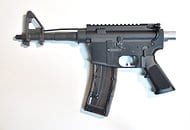 Lance Rosenfield for The New York Times Cody Wilson, a law student at the University of Texas, is working to design and create a gun using 3-D printing technology.
Lance Rosenfield for The New York Times Cody Wilson, a law student at the University of Texas, is working to design and create a gun using 3-D printing technology.It has long been possible to make a gun at home. But what happens when it no longer takes knowledge and skill to build one?
It won’t be long before a felon, unable to buy a gun legally, can print one at home. Teenagers could make them in their bedroom while their parents think they are “playing on their computer.” I’m talking about a fully functional gun, where the schematic is downloaded free from the Internet and built on a 3-D printer, all with the click of a button.
Hit print, walk away, and a few hours later, you have a firearm. There are no background checks. No age limits. No serial numbers etched on the barrel or sales receipts to track the gun.
It might sound like science fiction, but 3-D printers are quickly becoming a consumer product. These printers, which now cost about $1,000, can print objects by spraying thin layers of plastic, metal or ceramics that are built up into shapes. Long used by industrial companies to make prototypes and parts, 3-D printers are becoming faster and less expensive almost weekly. One manufacturer, MakerBot, has set up a retail store in Manhattan. Chinese companies have started making them, and prices are falling to about $500.

Hobbyists have printed fairly rudimentary objects: prosthetics, iPhone cases, cat statues and missing luggage clasps.
A number of people have already made gun parts using 3-D printers. And yes, the guns with these parts have successfully fired bullets. Cody Wilson, a law student at the University of Texas, is in the process of building a completely functional printed gun. “We hope to have this fully tested and put the files online in the next couple of months,” said Mr. Wilson, who runs a Web site called Defense Distributed.
He calls the gun the Wiki Weapon. In a video explaining the project’s goals, he describes the Wiki Weapon as the world’s first “3-D printable personal defense system.”
“What’s great about the Wiki Weapon is it only needs to be lethal once,” Mr. Wilson says in the video, in a monotone voice. “We will have the reality of a weapons system that can be printed out from your desk. Anywhere there is a computer, there is a weapon.”
Under most circumstances, it is not illegal to build your own gun, but it has been pretty difficult. Ginger Colbrun, a spokeswoman for the Bureau of Alcohol, Tobacco, Firearms and Explosives, said people had made firearms out of pens, books and belt buckles. But those contraptions and conventional firearms require a certain amount of knowledge and skill.
Ms. Colbrun said the agency was keeping a close watch on 3-D printers. “A.T.F. always tries to stay ahead of the illegal activity and the novel firearms trafficking schemes, without impinging on individuals’ rights,” she said.
But monitoring whether people make their own guns on a 3-D printer is going to be impossible, barring sticking an A.T.F. agent in every home. It’s also hopeless to try to build a technology into these printers that prevents people from printing a gun. One project mentioned in Mr. Wilson’s video, called the RepRap printer, will be capable of replicating itself by printing other 3-D printers.
After committing a crime with a printed weapon, a person could simply melt down the plastic and reprint it as something as mundane as a statue of Buddha. And guns made of plastic might not be spotted by metal detectors in airports, courthouses or other government facilities.
“This becomes scary when you consider the fact that it could be yet another opportunity for people to evade background checks and get a gun,” said Daniel Gross, president of the Brady Campaign to Prevent Gun Violence and the Brady Center to Prevent Gun Violence.
The National Rifle Association did not respond to a request for comment.
Given the number of existing loopholes and the ease with which people can buy firearms on the Internet, people printing guns might seem like adding a drop of water to an Olympic-size swimming pool. According to an annual report released by the A.T.F., more than 5.5 million guns are made in the United States each year, and millions more are imported.
“Forty percent of guns are sold through a loophole at gun shows, where people are already able to buy a firearm without having to go through a background check,” Mr. Gross said. “There’s already a permanent ‘gun show’ on the Internet.”
Michael Guslick, an amateur gunsmith who has written extensively online about the considerable challenges of 3-D printed guns, said people had been experimenting with homemade guns for some time. He said the most notable example was the zip gun, which is made from off-the-shelf plumbing parts. (Not surprisingly, the schematics and instructions can be downloaded online.)
“This is just applying a different technology to something that is already being done,” he said. “But making one on a 3-D printer is a lot of work when your local plumbing department is so close by.”
For now, the task isn’t as easy as hitting print, say the few people who have successfully built guns using 3-D printers. The basic problem is not the printing technology, but the lack of plastics strong enough for a real gun.
But this year, Mr. Guslick managed to print some components for an AR-15 semiautomatic assault rifle — the kind of gun used in the Aurora, Colo., shootings — on a 3-D printer. He used ABS plastic, “the same plastic used to make Legos.”
He was particularly interested in printing a part called the lower receiver, which connects the trigger, grip and magazine holder. “I used my home 3-D printer to make the lower receiver, which is the only regulated component of a gun,” he said. “Every other part you can legally pick up at your local gun shop.”


